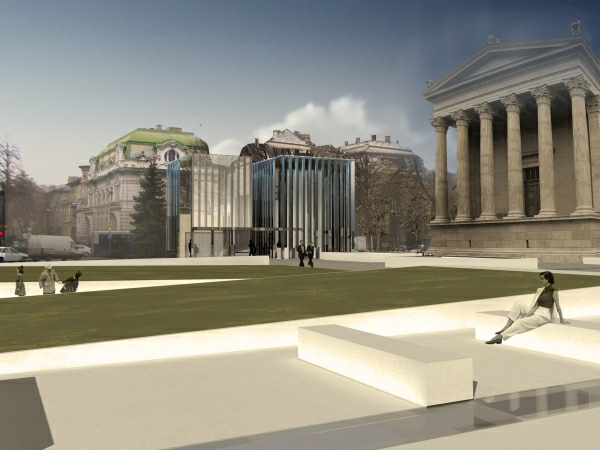Museum of Fine Arts Extension
Reflections Apropos of the Extension Project of the Museum of Fine Arts
The designing process is a kind of communication in itself. It is an imaginative internal exchange of ideas of the creator, a dialogue of ideas and form concept formulating and discarded, developed and enhanced. There is communication between the mind and the hand drawing designs. The exterior of communication starts with the definition of the task, together with the client, and takes place in a variety of social terrains. Sometimes stormily, as the „inner image” of the creator is being adjusted all the time the non-stop movement of society throughout the process of construction, whether it is a short or long period, and it is a difficult task for it to accommodate due to reasons mentioned above. In the recent past I witnessed all of his „exterior” at the jury of the central project of the Museum of Fine Arts. In a medium, where a No. 1 development (concerning a national treasure because of the building and primarily of the collection concerned, one of the few state-owned Hungarian institutions with international prestige), the preparation of the renewal of which is taking place among a confusion of communication, is in labour, which is an understatement here. One of the most astonishing fact is the lack of a relevant concept concerning the environs, as there is no such plan for the whole capital either. If Budapest shall have a brand based on consensus, the Museum of Fine Arts must play a key role in it in case it shall go through the current transformation – whether it is favoured or not –, during which the values preferred by a consumer society are harmonized with the often hidden genuine gems of the collection, the building and Heroes’ Square and the would-be Museum District projected by politicians on the site of today’s Western Railway Station.
György Szegő
Opponency Concerning the Design of the Extension Project of the Museum of Fine Arts
Architects: Tamás Karácsony, György Selényi, Ildikó Sebők
Three is the truth of Hungarians, and this may be true of the phases of the designing process of the underground extension of the Museum of Fine Arts with a life of vicissitudes. It is the third time that I have been asked to submit my opinion on this topic in writing. The first design made by Zsolt Szécsi was examined by the Monuments’ design committee two years ago, and soon later a new one was submitted by Tamás Karácsony and his fellow architects for the jury which by then was the Central Planning Board. Meanwhile (?) there was a competition published inviting designs where the opinions of many excellent architects were considered concerning this issue which is far from being easy to tackle. During the time passed since then debates were settling, people calmed down, it was almost unanimous that the best design won the tender and thus was commissioned to go on with the project. Of course there is no such thing as „the best design”, it is only a question of how we prioritize viewpoints, but there is no doubt that the committee chose the one which was most respectful of the relationship with the building by Schikedanz functioning as its background. Designers submitted then a more mature version of the original design, and the committee decided it was a high-standard one licensing it with only one modest proposal: that is the funcion of the main entrance stairs and the new entrance cut in it must be revised during the follow-up.
György Skardelli
On the Extension Project of the Museum of Fine Arts
It is the third time now that the architectural designs of the development of the Museum of Fine Ars are discussed by the Central Committee of Architectural Design and Technology headed by Sándor Fegyverneky. The project had always been the focus of attention, but now as a result of a campaign initiated this spring by József Sisa and Mihály Ráday Mihály drew the attention of the wider public to some issues which are only the surface of an underlying professional debate – which divides art historians and museologists, but not architects in general. This is how the session of the Committee meant to discuss the new designs of the extension of the museum has turned out to be also a forum of this dispute.
Zoltán Rostás
An Exemplary Construction: Neues Museum, Berlin
Adjustment and innovation – these are the key words calling applicants to enroll for the autumn course of the Doctor’s School of Budapest Technical Universiy (Deparment of Architecture). The topic is a homogeneous one and shall be defined more precisely by time, so that everyone concerned shall find his or her tailored personal interpretation.
Whilst there is a debate difficult to interpret on the reconstruction and extension project of the Museum of Fine Arts in Budapest, it was quite a refreshing experience to meet the large number of people applying for the Docor’ School. Refreshing, as all of them are talented young architects. Armed with faith and good intentions, in the hope of fresh impulses they are heading for the studies on offer.
Hearing the keywords and apropos of the Museum of Fine Arts of course the compelling experiences of hours spent in the Neues Museum are automatically evoked. A harmonious co-existence of adjustment and innovation is percepible here at its best. Every detail, every motion and reflection serves the very same goal: to find a delicate equilibrium of the old and the new, in relation of the building and an object d’art, in the materials used, in its organization, the inherent logic of things and their orderliness.
Tamás Karácsony













